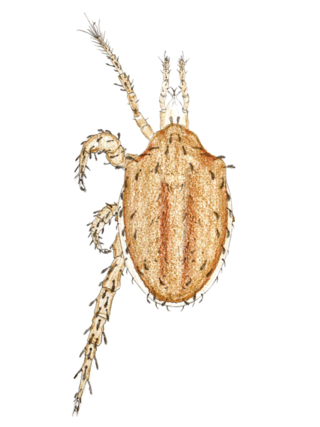Related Research Articles

Parasitiformes are a superorder of Arachnids, constituting one of the two major groups of mites, alongside Acariformes. Parasitiformes has, at times, been classified at the rank of order or suborder.

The peacock mites of the genus Tuckerella are a significant herbivorous pest in the tropics, for example on citrus fruit. Other species dwell in grasses, possibly as root feeders.

Tarsonemus is a genus of trombidiform mites within the family Tarsonemidae.
Hypoaspis is a genus of mites in the family Laelapidae.

Mesostigmata is an order of mites belonging to the Parasitiformes. They are by far the largest group of Parasitiformes, with over 8,000 species in 130 families. Mesostigmata includes parasitic as well as free-living and predatory forms. They can be recognized by the single pair of spiracles positioned laterally on the body.

The Laelapidae are a family of mites in the order Mesostigmata. The family is also referred to in the literature as Laelaptidae, which may be the correct spelling.

Dermanyssoidea is a superfamily of mites, including most of the mites which parasitise vertebrates.

Macrochelidae is a family of mites in the order Mesostigmata.
The family Ameroseiidae is one of the three families of mites under the superfamily Ascoidea. There are about 12 genera and more than 130 described species in Ameroseiidae. The family has a worldwide distribution.
Ascidae is a family of mites in the order Mesostigmata.
Asca is a genus of mites with worldwide distribution in the family Ascidae.
Gamasellodes is a genus of mites in the family Ascidae.

Proctolaelaps is a genus of mites in the family Ascidae.

Rhinonyssidae is a family of mites in the order Mesostigmata. There are about 16 genera and at least 460 described species in Rhinonyssidae.
Sejidae is a family of mites in the order Mesostigmata. The oldest known record of the group is an indeterminate deutonymph from the mid Cretaceous (Albian-Cenomanian) aged Burmese amber of Myanmar.

Blattisociidae is a family of mites in the order Mesostigmata.

Kleemannia is a genus of mites in the family Ameroseiidae. There are more than 20 described species in Kleemannia.

Sejida is a suborder of mites in the order Mesostigmata. There are about 5 families and 13 described species in Sejida. The oldest known record of the group is an indeterminate deutonymph belonging to Sejidae from the mid Cretaceous (Albian-Cenomanian) aged Burmese amber of Myanmar.
Melicharidae is a family of mites in the order Mesostigmata.
Uropodina is an infraorder of mites in the order Mesostigmata.
References
- ↑ David Evans Walter (ed.). "Ascidae Species Listing". Biology Catalog. Texas A&M University. Archived from the original on 7 August 2010. Retrieved August 29, 2010.
- 1 2 Long, Yun; Jin, Dao-Chao; Guo, Jian-Jun; Yi, Tian-Ci (2021-03-30). "A new species of Antennoseius (Vitzthumia) Thor (Acari: Mesostigmata: Ascidae) from China, with a key to species of the genus recorded from China". Acarologia. 61 (1): 46–54. doi: 10.24349/acarologia/20214416 .
- 1 2 3 "Opilioacariformes". idtools.org. Retrieved 2022-12-01.
- 1 2 3 4 "Antennoseius (Vitzthumia)". idtools.org. Retrieved 2022-12-01.
- ↑ Beaulieu, Frédéric; Déchêne, Andrea D.; Walter, David E. (2008-12-10). "Phase morphs and phoresy: New species of Antennoseius (Vitzthumia) mites (Acari: Mesostigmata: Ascidae) associated with pyrophilous carabids (Carabidae: Sericoda spp.) in Alberta, Canada". Zootaxa. 1961 (1): 37–57. doi: 10.11646/zootaxa.1961.1.4 . ISSN 1175-5334.
- 1 2 Joharchi, Omid; Marchenko, Irina I.; Stanyukovich, Maria K. (2022-06-30). "New data on some Antennoseius Berlese species (Acari: Ascidae) from Russia". Acarologia. 62 (2): 378–395. doi: 10.24349/4vni-nutt .